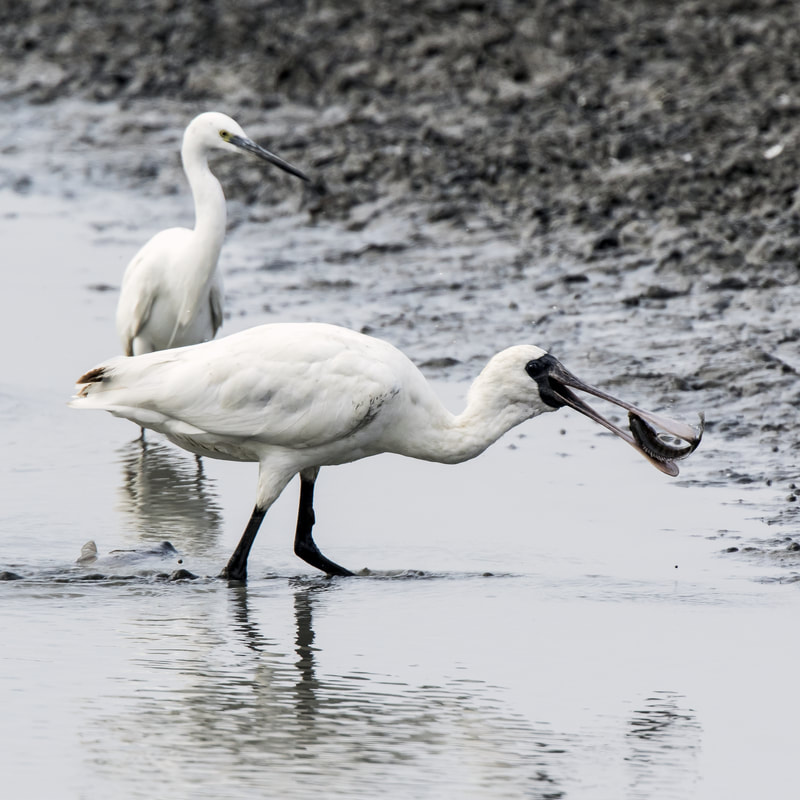|
The results of the International Black-faced Spoonbill Census 2017 has recently been made available. See http://www.hkbws.org.hk/web/eng/bfs_census_report_eng.htm .
This co-ordinated survey conducted on 13-15 January 2017 in all the known wintering areas came up with a total of 3,941 individual birds, which is a new high count and a far cry from the 300 that were known in the early 1990s. Taiwan is the most important area for wintering Black-faced Spoonbills with 2,601 birds (66% of the global population) being recorded; of these 1,810 were counted in the Tainan city area and 513 at Chiayi County. Away from Taiwan, Deep Bay in Hong Kong is the next most important wintering site for the spoonbills; 375 were recorded there and an additional 44 birds were counted in Macau. Despite the increasing numbers of Black-faced Spoonbills being recorded in East Asia, the species is still listed as Endangered by the IUCN as there is fear of “habitat loss to industrial development, land reclamation and pollution.” The spoonbills’ dependence on a few key sites tends to increase their vulnerability. We here in Hong Kong are lucky to have the Black-faced Spoonbill as a regular winter visitor. Unfortunately, and darkly ironic given the time and effort put into monitoring and protecting the species, there have recently been sightings in Hong Kong of spoonbills that have fallen victim to illegal gin traps. At least three birds have been involved to date, one of which was found dead. Of the other two, one in particular has little chance of surviving as the trap has clamped shut around its bill making it impossible for the bird to feed. See the HKBWS website: http://www.hkbws.org.hk/BBS/redirect.php?tid=27077&goto=lastpost#lastpost Hopefully, information will come to light of which fish ponds these traps are being used at so that the authorities will be able to take appropriate action.
0 Comments
 The Helmeted Hornbill Rhinoplax vigil inhabits the (diminishing) forests of southern Myanmar, Thailand, Malaysia, Borneo and Sumatra. Like other hornbills, this species has a conspicuous casque above its beak. Unlike most other hornbills, however, the casque of the Helmeted Hornbill is made up of solid keratin which is the same material as found in human hair and fingernails, as well as in rhino horn. This hornbill keratin is known as “red ivory” and – similar to the dentine that constitutes the ivory of elephant tusks - is carvable. In a 2015 article in BirdingASIA*, Nigel Collar noted that the use of this keratin for carved ornaments by the natives of Borneo is at least 2,000 years old and that trade between Borneo and China dates back to at least 700 A.D.; this included trade in “red ivory”, which even as long ago as the 14th century was far more expensive than elephant ivory. Collar notes that “Chinese carvings of hornbill ivory were exquisite; status-enhancing items such as belt buckles, seals, figurines, snuff boxes, plume holders, hair-grips, buttons, thumb-rings and bracelets could be fashioned from it.” By the 1950s , however, demand for the red ivory in China had ceased to exist. Unfortunately, as a result of recent socio-economic changes, the demand for “status-enhancing items” in China has recently snowballed with disastrous results for the Helmeted Hornbill, which is now categorised as Critically Endangered by the IUCN. Black market prices for red ivory are up to five times higher than elephant ivory and sophisticated criminal networks already supplying animals, plants and their by-products to Chinese clients have, since 2011, added red ivory to the illegal products they deal in. The figures quoted by Collar based on information from experts on the ground in Southeast Asia are depressing: 500 Helmet Hornbills killed monthly in West Kalimantan in 2013; 1,111 Helmet Hornbill casques en route to China confiscated by Indonesian authorities between 2012 and 2014; hundreds of birds per month received by a middleman in the Chinese ivory trade from Sumatra in 2014/2015. The trade in red ivory is covered in an article by Sarah Lazarus in today’s (January 14, 2018) South China Morning Post. See http://www.scmp.com/magazines/post-magazine/long-reads/article/2127802/why-chinese-demand-red-ivory-dooms-helmeted . Lazarus updates the ground covered by Collar and adds a local element to the story, noting that Hong Kong is a key import hub for smuggling Helmet Hornbill casques into China. She illustrates this with a number of cases of people caught trying to move the casques across the border into the mainland. The fines and sentences given to these smugglers have so far been derisory and hardly likely to act as an effective deterrent. (Although, to be frank, the people caught at the border are just minor, dispensable pawns in this lucrative game – one HK man they caught said he was offered a mere HK$360 to smuggle 14 Helmeted Hornbill skulls into Shenzhen.) From Hong Kong and Shenzhen, a lot of the unprocessed casques are transported by road to Putian in Fujian province. Here, much of the red ivory is processed into beads – apparently beaded bracelets and necklaces are a fashionable trend among the middle classes in China. So a combination of vanity and greed is driving yet another species to unnecessary extinction. *Collar N.J. (2015) Helmeted Hornbills Rhinoplax vigil and the ivory trade; the crisis that came out of nowhere. BirdingASIA 24: 12-17. |

 RSS Feed
RSS Feed
